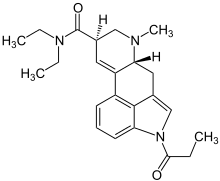1P-LSD
 | |
| Legal status | |
|---|---|
| Legal status |
|
| Identifiers | |
| |
| CAS Number |
|
| PubChem CID | |
| ChemSpider | |
| UNII | |
| Chemical and physical data | |
| Formula | C23H29N3O2 |
| Molar mass | 379.50 g·mol−1 |
| 3D model (JSmol) | |
| |
| |
1P-LSD or 1-propionyl-lysergic acid diethylamide is a psychedelic drug of the lysergamide class that is a derivative and functional analogue of LSD and a homologue of ALD-52. It has been sold online as a designer drug since 2015.[1][2][3][4][5][6]
Pharmacology
In mice, 1P-LSD produces LSD-like effects with 38% the potency of LSD and it is therefore classed as a serotonergic hallucinogen.[7] However, 1P-LSD itself is unable to bind to the serotenergic 5-HT2A receptors.[8][9] But since LSD is detected when 1P-LSD is incubated in human serum,[7] 1P-LSD may act, at least in part, as a prodrug for LSD.
Prior to the publishing of the above cited research, pharmacologist David E. Nichols reportedly commented with his thoughts on 1P-LSD serotonin receptor binding:[10]
| “ | I am sure that the 1-propionyl would also hydrolyze off of an indole, but I don't know whether in vivo conditions would work. In a chemistry lab, you can get off an N-benzoyl, so an N-propionyl will probably come off too. But in the body? I don't know the answer to that. The compound would not be active as the N-propionyl however. The way that LSD docks into the 5-HT2A receptor, the indole NH hydrogen bonds to serine 5.46. With the propionyl, it won't fit into the receptor. | ” |
Effects

The effects profile of 1P-LSD is not well defined in the scientific literature. It is generally thought to be comparable to that of LSD.[11] Many anecdotal reports indicate that 1P-LSD has a slightly shorter duration than LSD in humans, with the majority of users stating that they cannot distinguish the qualitative effects of 1P-LSD from LSD.
Legal status
International
1P-LSD is not scheduled by the United Nations' Convention on Psychotropic Substances.[12]
Belgium
1P-LSD is illegal in Belgium since 26 September 2017.[13]
Denmark
1P-LSD is illegal in Denmark.[14]
Finland
1P-LSD is illegal in Finland.
Germany
1P-LSD is not regulated by law in Germany.
Japan
1P-LSD is illegal in Japan since 18 April 2016.[15]
Latvia
1P-LSD is illegal in Latvia. Although it isn't specifically scheduled, it is controlled as an LSD structural analog due to an amendment made on June 1, 2015.[16]
Lithuania
1P-LSD is illegal in Lithuania.
Norway
1P-LSD is illegal in Norway.[17]
Poland
1P-LSD is legal in Poland.
Sweden
Public Health Agency of Sweden added 1P-LSD as health hazard under the act Act on the Prohibition of Certain Goods Dangerous to Health (SFS 1999:42) in Sweden as of January 26, 2016, published in SFS 2015:997 listed as N,N-dietyl-6-metyl-1-propionyl-9,10-didehydroergolin-8-karboxamid (1P-LSD).[18]
Switzerland
1P-LSD is illegal in Switzerland.[19]
United Kingdom
Although not explicitly listed under the Misuse of Drugs Act 1971, 1P-LSD may be covered in the UK under the Psychoactive Substances Act.
United States
While 1P-LSD is not controlled at the federal level in the United States, it's possible that 1P-LSD could be considered as an analogue of LSD, in which case trade or possession with intent for human consumption could be prosecuted under the Federal Analogue Act.[20]
See also
References
- ↑ "Philtre Bulletin Issue 5" (PDF). WEDINOS. March 2015. Retrieved 28 July 2015.
- ↑ Max Daly (27 July 2015). "Why Young Brits Are Taking So Much LSD and Ecstasy". Vice. Retrieved 11 August 2015.
- ↑ "Newer Unregulated Drugs" (PDF). KFx. April 2015. Retrieved 13 August 2015.
- ↑ Matthew Speiser (11 August 2015). "A handful of dangerous new legal drugs has public health experts worried". Business Insider UK. Retrieved 13 August 2015.
- ↑ "1P-LSD". New Synthetic Drugs Database.
- ↑ Joseph J. Palamar; Patricia Acosta; Scott Sherman; Danielle C. Ompad; Charles M. Cleland (June 2016). "Self-reported use of novel psychoactive substances among attendees of electronic dance music venues". The American Journal of Drug and Alcohol Abuse. 42 (6): 1–9. doi:10.1080/00952990.2016.1181179. PMC 5093056. PMID 27315522.
- 1 2 Simon D. Brandt; Pierce V. Kavanagh; Folker Westphal; Alexander Stratford; Simon P. Elliott; Khoa Hoang; Jason Wallach; Adam L. Halberstadt (October 2015). "Return of the lysergamides. Part I: Analytical and behavioural characterization of 1-propionyl-d-lysergic acid diethylamide (1P-LSD)". Drug Testing and Analysis. 8 (9): 891–902. doi:10.1002/dta.1884. PMC 4829483. PMID 26456305.
- ↑ Jose (15 October 2015). "Is 1P-LSD A Prodrug To LSD?". Detect-Kit. Retrieved 15 October 2015.
- ↑ P. Linda; A. Stener; A. Cipiciani; G. Savelli (January–February 1983). "Hydrolysis of amides. Kinetics and mechanism of the basic hydrolysis of N-acylpyrroles, N-acylindoles and N-acylcarbazoles". Journal of Heterocyclic Chemistry. 20 (1): 247–248. doi:10.1002/jhet.5570200154.
- ↑ kman1898 (16 February 2015). "The Big & Dandy 1P-LSD Thread, Volume 1". Bluelight.
- ↑ Fabrizio Schifano; Laura Orsolini; Duccio Papanti; John Corkery (June 2016). "NPS: Medical Consequences Associated with Their Intake". Neuropharmacology of New Psychoactive Substances (NPS). Current Topics in Behavioral Neurosciences. 32. pp. 1–30. doi:10.1007/7854_2016_15. ISBN 978-3-319-52442-9. OCLC 643052237. PMID 27272067.
- ↑ "International Drug Control Conventions". United Nations Office on Drugs and Crime (UNODC).
- ↑ "Royal decision regarding regulation of sedative substances, psychotropic substances" (PDF). Federal Agency for Medicines and Health Products. 26 September 2017.
- ↑ "Lists of euphoriant substances". The Danish Medicines Agency. September 2015.
- ↑ "指定薬物一覧" (PDF) (in Japanese). Ministry of Health, Labour and Welfare.
- ↑ "Noteikumi par Latvijā kontrolējamajām narkotiskajām vielām, psihotropajām vielām un prekursoriem" (in Latvian). Latvijas Republikas tiesību akti.
- ↑ "31 Forskrift om narkotika (narkotikaforskriften)" (in Norwegian). Helse- og omsorgsdepartementet. 14 February 2013.
- ↑ https://notisum.se/rnp/sls/sfs/20150997.pdf
- ↑ "Verordnung des EDI über die Verzeichnisse der Betäubungsmittel, psychotropen Stoffe, Vorläuferstoffe und Hilfschemikalien" (in German). Der Bundesrat.
- ↑ "Introduction to the Federal Controlled Substance Analogue Act". Erowid. January 2001.